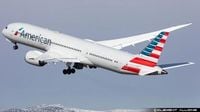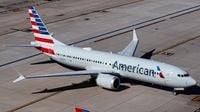On June 2, 2025, American Airlines Flight AA780, en route from Philadelphia to Naples, Italy, was abruptly diverted to Rome's Leonardo da Vinci Fiumicino Airport due to an unexpected operational hurdle: the aircraft was simply too large for Naples International Airport to accommodate safely. The Boeing 787-9 Dreamliner, which took off from Philadelphia at 7:42 PM local time, was scheduled to land in Naples at 10:00 AM the following day. However, as the plane neared its destination, about 70 miles away, the pilots altered course, redirecting the flight northward to Rome, where it touched down around 9:45 AM.
American Airlines attributed the diversion to "operational limitations," a somewhat vague explanation that raised eyebrows among aviation experts and passengers alike. The crux of the issue lies in the aircraft type: the 787-9 variant is 20 feet longer than the Boeing 787-8, which American Airlines typically deploys on this route. While both variants share the same wingspan of 197.3 feet, the longer fuselage of the 787-9 requires a higher category of Rescue and Fire Fighting Services (RFFS) at the destination airport. Specifically, the 787-9 demands a Category 9 RFFS airport, whereas Naples International Airport is rated Category 8, suitable only for smaller wide-body aircraft like the 787-8.
This distinction, while technical, has significant operational consequences. The International Civil Aviation Organization (ICAO) sets these categories based on aircraft size and the corresponding emergency response capabilities required. Naples' current infrastructure simply does not meet the standards necessary to safely handle a 787-9. Aviation enthusiast and commentator @xJonNYC first brought the incident to public attention on the social media platform X, citing airport sources confirming that the larger 787-9 is not permitted to land at Naples.
Passengers aboard Flight 780 faced an unexpected detour. After landing in Rome, they were bused approximately 145 miles to Naples, a journey that took over two hours. The airline apologized for the disruption, stating, "We apologize to our customers for this disruption to their journey." The diverted aircraft later departed Rome for Chicago as Flight 111, resuming its transatlantic schedule.
This incident highlights growing pains in the aviation industry as airlines increasingly operate larger, more efficient aircraft on international routes, sometimes outpacing the infrastructure capabilities of smaller airports. Naples International Airport, classified as an ICAO code 4D airport, has long accommodated the 787-8 variant without issue since American Airlines launched its seasonal service from Philadelphia to Naples in May 2025. That service has enjoyed strong demand, averaging load factors of 89% between June and October 2024.
However, the decision to deploy a 787-9 on June 2 exposed the airport's limitations. The 787-9's fuselage measures 203 feet 5 inches, compared to 183 feet 5 inches for the 787-8. This additional length increases the aircraft's emergency service requirements, which Naples currently cannot fulfill. The airport’s Category 8 RFFS rating means it does not have the firefighting and rescue capabilities mandated for the larger aircraft.
While the diversion was inconvenient for passengers, it also raised broader questions about the capacity of smaller airports to keep pace with evolving aircraft technology and airline operational needs. As airlines seek to maximize efficiency and capacity, smaller airports face pressure to upgrade infrastructure or risk becoming bottlenecks that disrupt travel plans.
Passengers' frustration was palpable. Some criticized American Airlines for what they described as a "broken process," citing recent experiences of delays, cancellations, and downgrades with the carrier. One passenger recounted missing connections to Barbados due to delays and expressed dismay at the airline's refund policies, while another described a "nightmare" journey to Costa Rica involving missed connections and lengthy drives.
Despite these complaints, American Airlines plans to introduce new "automatic delay" technology this summer to help passengers make connections more smoothly. Yet, the Naples incident underscores how even small operational oversights—like sending a slightly larger aircraft than the airport can handle—can ripple into significant passenger inconvenience.
Following the diversion, alternative travel options were made available. Italy's national carrier, ITA Airways, operated multiple flights from Rome to Naples on June 3, with departures at 9:30 AM, 11:30 AM, 2:30 PM, 4:30 PM, 6:30 PM, and 8:30 PM, helping stranded travelers reach their intended destination.
The episode also serves as a reminder that non-European Union carriers like American Airlines are not bound by EU261 compensation rules, which typically require airlines to compensate passengers for delays or diversions within the EU. This regulatory nuance leaves passengers with limited recourse in such situations.
In the grander scheme, the diversion of Flight AA780 spotlights the challenges faced by airports like Naples that, while internationally recognized, may lack the infrastructure to accommodate the latest generation of widebody jets. As airlines continue to modernize fleets and optimize routes, airport authorities must evaluate and potentially upgrade facilities to keep pace with these changes.
For now, passengers on Flight 780 had to endure an unexpected road trip across Italy, a small price to pay amid the complexities of global air travel. But for the industry, the incident serves as a cautionary tale about the importance of aligning aircraft deployment with airport capabilities to avoid such disruptions in the future.


